Updated November 2023.
If you are looking to drive high-value MQLs and raise the CLV of your SaaS organization, you need a killer SaaS content marketing strategy.
Software as a service products often involve complex technologies and solutions. Content marketing allows companies to educate their target audience about the benefits, features, and functionalities of their products to elevate your SaaS sales.
Moreover, producing high-quality content positions your SaaS company as an authority in your industry, which leads to higher organic rankings and traffic.
In this article, we’ll walk you through the 6 steps required to create your own successful SaaS content strategy, including all the tactics, methods and tools you’ll need.
Differences Between Traditional Content Marketing and SaaS Content Marketing
Here are the top differences between traditional content marketing and SaaS content marketing:
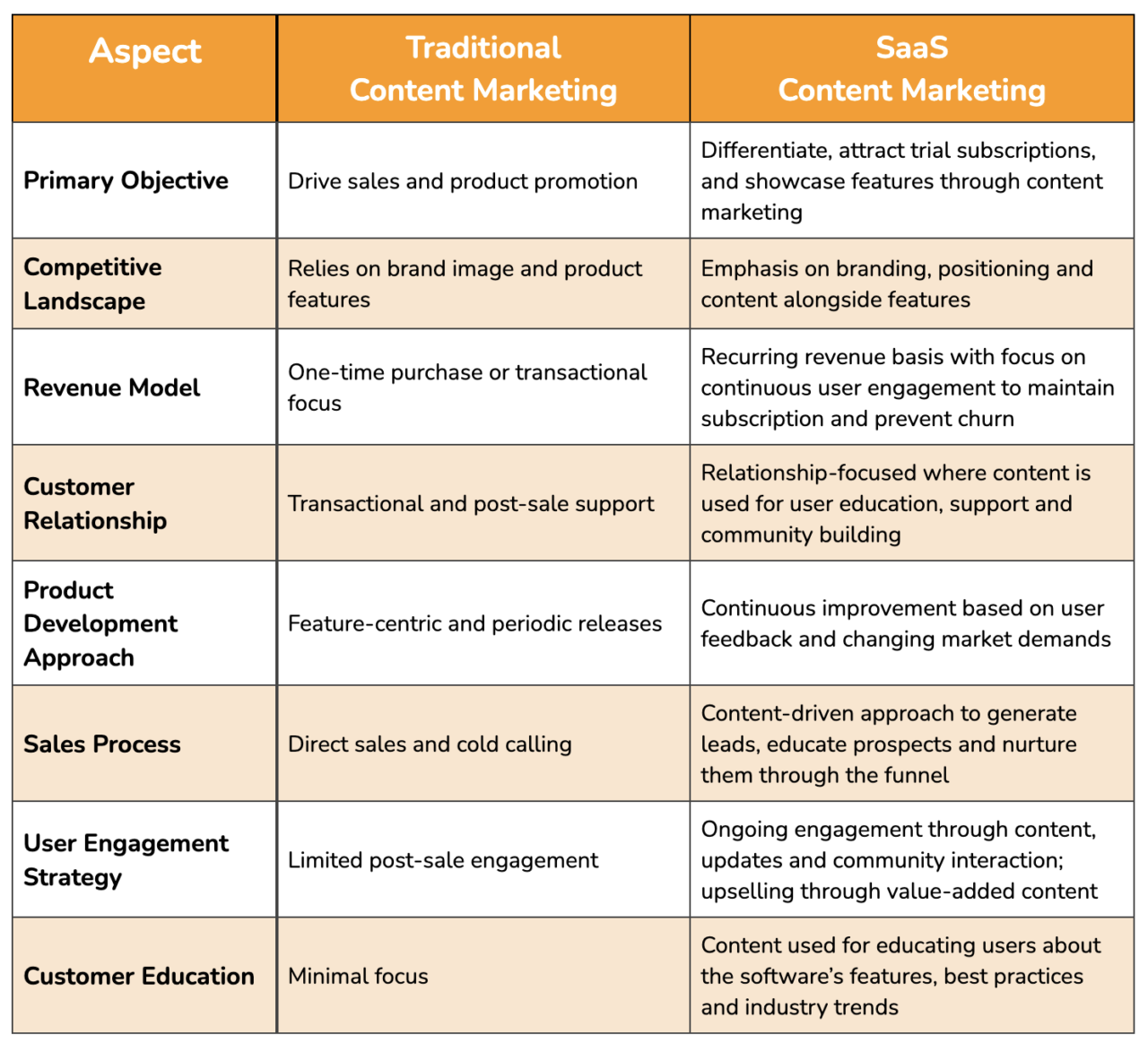
Why Content Marketing Is Important for SaaS Companies
Content marketing is crucial for SaaS companies for several reasons:
- Providing User Education: SaaS offerings frequently offer solutions to intricate challenges. Utilizing content marketing enables companies to craft informative materials like blog posts, white papers, and tutorials. These resources assist users in comprehending the software’s value, mastering effective usage, and understanding how it caters to their particular requirements.
- Establishing Trust and Credibility: Trust holds paramount importance in SaaS marketing sector. SaaS companies can solidify their position as industry leaders and cultivate trust with their audience by consistently generating top-notch content that tackles users’ challenges and imparts valuable insights.
- SEO Advantages: Maintaining a strong online presence is heavily reliant on Search Engine Optimization. Content marketing, encompassing blog posts and various content formats, plays a pivotal role in boosting a SaaS company’s search engine rankings. This, in turn, simplifies the process for potential customers to discover your SaaS product when seeking solutions to their challenges.
- Lead Generation: Content marketing serves as a powerful tool for lead generation. By offering valuable content such as ebooks, webinars, or downloadable resources, SaaS companies can capture leads and nurture them through the sales funnel.
- Customer Retention: Beyond acquiring new customers, successful SaaS content marketing processes are valuable for retaining existing customers. Providing ongoing value through relevant and helpful content keeps customers engaged and reinforces the value of the SaaS product over time.
- Showcasing Expertise: SaaS companies create content to showcase their expertise in the industry. This can include thought leadership articles, case studies, and success stories that demonstrate the company’s understanding of market trends and its ability to deliver results.
- Standing Out in a Competitive Market: The SaaS industry is frequently saturated with numerous companies offering comparable solutions. Employing content marketing enables a company to distinguish itself by highlighting its distinctive features, advantages, and approach to addressing customer issues.
- Aligning with the Buyer’s Journey: SaaS acquisitions often entail a prolonged decision-making process. Content marketing empowers companies to craft content that corresponds to various stages of the buyer’s journey, ranging from awareness and consideration to decision-making. This guarantees that your potential customer can access pertinent information at the appropriate stages.
- Engaging on Social Media: SaaS enterprises can utilize content marketing across social media platforms to interact with their audience, disseminate updates, and actively participate in industry conversations. Social media serves as a valuable conduit for content distribution and driving traffic to the company’s website.
Common Pitfalls That Can Occur Without a SaaS Content Marketing Strategy
The absence of a content strategy for SaaS businesses companies can expose them to several significant dangers:
- Limited brand visibility: Without a content marketing strategy, a SaaS company may struggle to establish and maintain a strong online presence. This can lead to limited brand visibility, making it challenging for potential customers to discover the product.
- Lack of targeted messaging: A content marketing strategy helps in crafting targeted messages that resonate with specific audience segments. Without this strategy, there’s a risk of generic and ineffective communication that fails to address the unique needs and pain points of the target audience.
- Lower content engagement and reach: Not only will you put yourself at risk of producing content that no-one cares about, but without creating a promotional strategy to decide how you’ll attract people to your content, you’ll reach a far smaller audience and your content marketing results will suffer.
- Delays, inefficiencies and rising costs: With a strategy in place, your SaaS content marketing will run like a well-oiled machine, with defined costs, deadlines and expectations for each part of the process. Without it, content will be produced inconsistently and coordination between different people in the process will be inefficient, which naturally will lead to delays and rising costs.
- Lack of management buy-in leading to budget cuts: SaaS content marketing is a long-term strategy that’s unlikely to yield instant results. So in order to be successful, every relevant stakeholder within the company must truly believe in it. Otherwise, if you aren’t able to demonstrate any tangible results within the first few months, you could experience internal pressure to stop. However, by creating a killer strategy first, you can share it and get buy-in from others within the company to (hopefully) prevent this from happening.
- Inability to measure success: If you never define what your goals are or what represents a successful outcome, you won’t be able to objectively measure how well your content marketing efforts are performing. Specifically, when it comes to SaaS content marketing, tracking, attributing and measuring results is far trickier than most other companies who have the goal of gaining sales.
- Insufficient employee advocacy: Content marketing can benefit from employee advocacy. Without a strategy to involve and empower employees in content creation and promotion, a SaaS company may miss out on the amplification of its message through the networks of its own team members.
- Ignoring customer feedback loop: Content marketing is not just about broadcasting messages; it’s also about engaging with the audience. Without a strategy, there may be a failure to establish a robust feedback loop, missing valuable insights from paying customers that can inform content creation and product improvements.
- Overlooking content repurposing: Without a content strategy, there’s a risk of underutilizing existing content. Repurposing content for different formats and platforms can extend its lifespan and reach, maximizing its impact. Without a strategy, valuable content may go underutilized or be overlooked for repurposing opportunities:
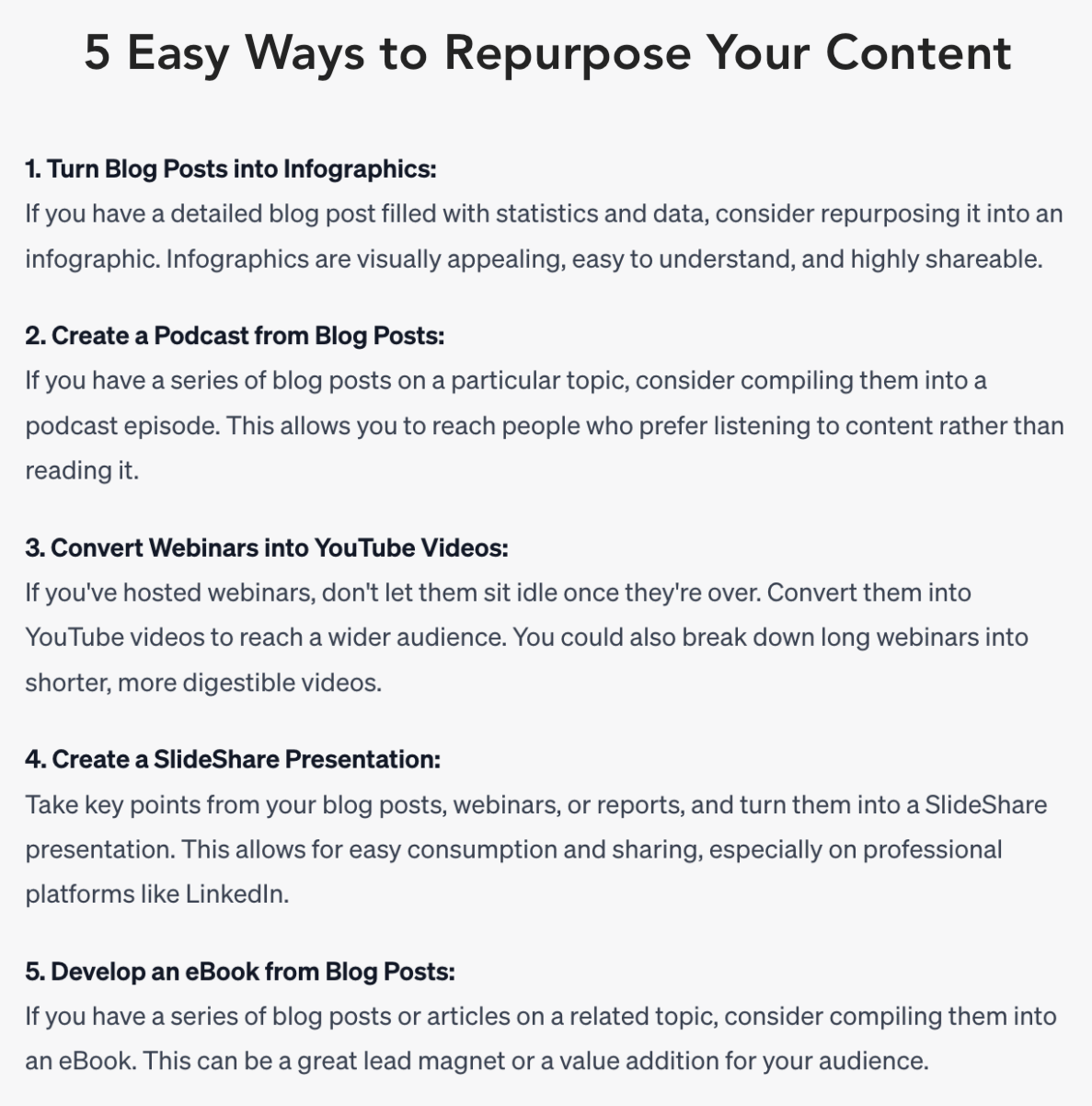
A Step-by-Step Guide to Creating a Killer SaaS Content Marketing Strategy
Now that you know why a content marketing strategy for SaaS companies is so important, here is a 6-step guide on how to create one.
Step 1 – Understanding Your Audience
The first step to understand your target audience is to create a buyer persona and a customer journey map.
Buyer Persona Development
A buyer persona is a semi-fictional representation of your ideal customer, based on market research and real data about your existing customers. It includes demographics, behavior patterns, motivations and goals.
Creating a buyer persona is crucial for understanding your audience. This document, which can be as simple or as detailed as you want, will help you immensely in tailoring your marketing strategies and content to better resonate with the specific needs, behaviors and concerns of your target audience.

Here’s the basic info you’ll need for it:
- Identify Primary Stakeholders: Recognize the key participants in the decision-making process for your SaaS product. This group may encompass end-users, decision-makers, influencers and administrators.
- Collect Demographic Information: Acquire relevant demographic details pertaining to your target audience, such as age, location, job title, industry and company size.
- Understand Pain Points: Identify the challenges and pain points your audience faces that your SaaS product can address. This information is crucial for tailoring your content to meet specific needs.
- Define Goals and Objectives: Determine the goals and objectives your audience aims to achieve with your SaaS solution.
Customer Journey Mapping
While a buyer persona focuses on who the customer is, a customer journey map details their experience and interaction with your business over time. This map outlines the various stages a customer experiences, from initial awareness to post-purchase, and highlights their feelings, motivations and challenges at each step.
Here’s the basic info you’ll need for it:
- Outline the Journey Stages: Break down the customer journey into stages, including awareness, consideration, decision-making, onboarding and retention. Here is a sample of a SaaS customer journey map:

- Identify Touch Points: Pinpoint the various touch points where your audience interacts with your brand, from the initial discovery to ongoing usage.
- Content Alignment: Align specific types of content with each stage of the customer journey. For example, educational content for awareness, case studies for consideration and tutorials for onboarding.
- Define Key Metrics: Determine metrics for success at each stage. This could include lead generation metrics, conversion rates, customer satisfaction scores, and retention rates.
Step 2 – Setting SMART Goals and Clear KPIs
Below is a list of the most common content marketing goals and KPIs for SaaS companies – we advise choosing one goal only.
Goal 1: Increase Your SEO Rankings
Indicators that this may be the right goal for your SaaS:
- Your conversion rate from organic traffic is highest amongst your acquisition channels
- Your target customers often search for information about desires/pains that relate to your software
- Your competitors rank higher than you for most common customer searches
- Producing better content and ranking higher than your competitors is realistic based on your budget
- You are too reliant on paid ads for user acquisition (particularly if your CAC is rising)
Most common KPIs to measure the success of an SEO-focused B2B SaaS content strategy:
- The number of relevant keywords you rank for
- Your specific ranking for those keywords
- Website traffic from search engines
- Number of backlinks pointing to your content
- Conversions from search engine traffic
Goal 2: Increase Your User Engagement
Indicators that this may be the right goal for your SaaS:
- User churn is a big issue (typically for SaaS, a churn rate above 5% is considered worrisome, though this varies depending on the specific industry)
- Your software operates in a space where users typically need educating (e.g. e-commerce SaaS – where software like JungleScout relies on helping new Amazon sellers but has a churn rate in excess of 80%)
- Customer feedback indicates that users are churning due to a lack of information
- Your LTV:CAC ratio is under 3:1 and therefore it may be more profitable to focus on retaining existing users as opposed to acquiring new ones
Most common KPIs to measure the success of an engagement-based strategy:
- Churn rate (%)
- Average user monthly session duration (% change)
- Daily Active Users/Monthly Active Users (%)
- The average number of logins per user per month (% change)
- Social engagement indicators such as comments, shares and likes
Goal 3: Increase Your Brand Recognition
Indicators that this may be the right goal for your SaaS:
- You’re a newcomer to the field, competing against SaaS companies that have been operating for years
- You’re marketing your software to appeal to a new audience
- You have low market recognition amongst your target customers
- You have the budget to share your content widely using tactics such as paid ads and influencers
Most common KPIs to measure the success of a content marketing strategy based on increasing brand recognition:
- Site traffic/number of website visitors
- Social engagement indicators, such as comments, views, shares and likes (you can track social media activity using tools such as Mention)

Goal 4: Capturing Lead Information (Including Emails)
Indicators that this may be the right goal for your SaaS:
- Your main website conversion goal is for users to sign up for a product demo instead of a trial
- You sell high-value or enterprise software where multiple stakeholders are involved in buying decisions
- Leads normally require nurturing or educating before deciding to join
Most common KPIs to measure the success of a content marketing strategy based on capturing lead information:
- New leads/demo sign-ups
- Lead magnet downloads
Goal 5: Attracting New Users (Trial or Paid)
Indicators that this may be the right goal for your SaaS:
- User acquisition is your greatest challenge (as opposed to retention or monetization)
- You have a healthy churn rate for your industry (typically below 5%)
- You have an above-average SaaS website conversion rate
- There are indications that content is a big factor in the purchasing decisions of potential users (you can check your own customer feedback or reviews on websites like Trustpilot to give you an idea)
Most common KPIs to measure the success of a content marketing strategy based on attracting new users:
- Trial user sign-ups
- Paid user sign-ups
Step 3 – Content Audit and Competitor Analysis
Now that we know who our audience is and have decided on our goal for our content marketing strategy, we need to review the content that we already have (so we don’t duplicate it and compete against ourselves) and the content that’s already out there from our competitors.
Content Audit
A content audit will identify the strengths and weaknesses of your existing content, thus revealing opportunities for improvement and making sure it aligns with your current marketing goals.
To analyze your current website content to identify what’s working and what’s not, follow these steps:
- Content Inventory: List all the types of content you have, such as blog posts, white papers, case studies, webinars, and product documentation. Categorize content based on the stage of the buyer’s journey (awareness, consideration, decision).
- Performance Metrics: Analyze metrics like website traffic, conversion rates on trial sign-ups, and engagement on your SaaS landing pages. In your content audit, identify which pieces contribute most to lead generation and customer acquisition:

- Quality Assessment: Ensure that product information and feature content are up to date. Evaluate the usability and relevance of any educational content, such as tutorials or how-to guides.
- SEO Analysis: Assess the SEO effectiveness of content by examining keyword rankings, backlinks, and organic search traffic. Optimize content for relevant industry-specific keywords and ensure alignment with customer search intent.
- User Feedback: Collect user feedback through customer support channels and online reviews. Identify common questions or concerns to address in content updates or future publications.
Competitor Analysis
Competitor analysis provides insights into the strategies, content types and performance of your competition, and knowing this will allow you to identify gaps in their approach and, thus, areas where you can differentiate and excel.
To analyze the content marketing efforts of your competitors to identify opportunities and threats, follow these steps:
- Identify Competitors: Identify direct and indirect competitors using competitor analysis tools like Semrush or Ahrefs. Focus on those targeting similar customer segments or offering comparable solutions.
- Content Types and Frequency: Analyze the types of content your competitors are creating. For example, do they prioritize blog posts, webinars or interactive tools? Determine how frequently they update their content to stay relevant in the dynamic SaaS landscape.
- Audience Engagement: Evaluate the level of engagement on their social media platforms and blog comments. Identify which topics or content formats resonate the most with their audience.
- SEO and Keywords: Examine competitors’ keyword strategies and identify opportunities to target keywords they might be missing. Monitor their organic search performance and backlink profiles.
- Social Proof and Case Studies: Look for social proof elements like customer testimonials and case studies. Analyze how competitors showcase successful use cases and customer stories in their content:

- Product Updates and Announcements: Monitor how competitors announce and market new features or product updates. Identify opportunities to differentiate your SaaS offering or emphasize unique selling points.
- Unique Strategies and Innovations: Identify any unique SaaS content marketing strategies, such as interactive content, quizzes or proprietary research, that competitors are employing. Evaluate whether these strategies align with your brand and if there’s potential to adapt or improve them.
Step 4 – Content Creation
Ok, now we’re finally ready to start creating our data-backed content! In this step, there are two things to focus on: keyword research and the kind of content you’ll produce.
Keyword Research
Before you begin creating content, you should know which keywords you are targeting for your SaaS content campaign.
Begin your keyword research by brainstorming seed keywords (short, one or two-word phrases) that are directly related to your SaaS product or service. Consider your audience’s language when searching for solutions in your industry. These primary search queries will be the basis for expanding your list to include more specific and relevant terms.
To make this easy, use keyword research tools such as Google Keyword Planner, Semrush, Ubersuggest, Ahrefs and WordStream. These tools provide insights into search volumes, competition levels, and related keywords, so use the date you find to identify potential keywords that match your SaaS offering and industry.
When selecting keywords, pay close attention to the intent behind each search query, such as is illustrated in this table:

In other words, determine whether users are seeking information about your SaaS offerings, exploring product options, or ready to purchase. Then tailor your content to match the identified intent so that it aligns with the stage of the buyer’s journey associated with each keyword.
Here is a great example of how you should group your keywords to target the best keywords in your B2B SaaS content marketing strategy:

Content Production
Remember, your goal from step 2 of this guide (Setting SMART Goals and Clear KPIs) should be influencing every decision you make from now on.
Once you have prepared a list of keyword and content ideas, the next step is to create SaaS content that addresses the needs and pain points of your target audience.
There are many types of content that you could choose to produce, including:
- Articles: Incorporating articles into your SaaS content marketing strategy offers versatility. How-to guides provide step-by-step instructions, showcasing your expertise and helping users solve specific problems. Ultimate guides offer comprehensive insights into broader topics, establishing your brand as an authoritative resource.
- E-books: As long-form content pieces, e-books are valuable resources and can act as lead magnets to capture user information. Case studies present real-world examples of your SaaS solution, offering social proof, while feature updates keep your audience informed and engaged with the latest enhancements.
- Videos: Videos bring a dynamic element to your content strategy. Product demos visually showcase your software’s features, providing a hands-on experience for potential users. Tutorials guide users through specific aspects of your software, making complex processes more accessible. Explainer video content simplifies intricate concepts so that your audience easily comprehends the value of your SaaS offering.
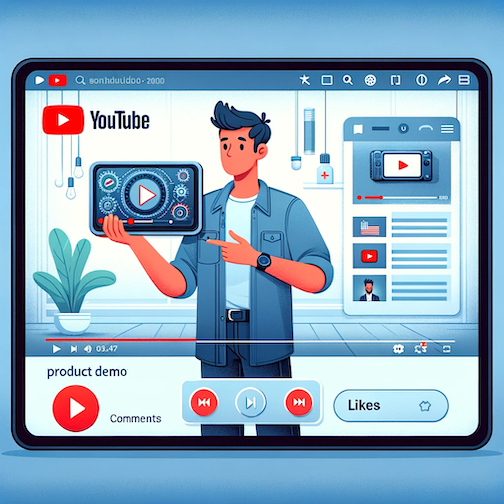
- Webinars: Webinars provide a real-time, interactive platform to connect with your audience. They are ideal for addressing complex topics, answering questions, and announcing significant updates. The live nature of webinars fosters engagement and allows for direct interaction with your audience, making them a powerful tool for SaaS content marketing.
- Podcasts: Podcasts offer a conversational and on-the-go content format. They provide an excellent avenue to share industry insights, conduct expert interviews, and discuss relevant topics in your niche. The audio format allows users to consume content while multitasking, making podcasts convenient and accessible for reaching your audience.

- Online Courses: Integrating online courses into your content strategy positions your brand as an educational authority. These courses provide a structured learning experience, allowing users to deepen their understanding of your SaaS product or industry. Educational content fosters trust and establishes your brand as a valuable resource for continuous learning.
- Infographics: Infographics visually represent information, making complex data or concepts easily digestible. They are effective for conveying statistics, illustrating processes or presenting comparisons in a visually appealing manner, like this one about marketing moats:
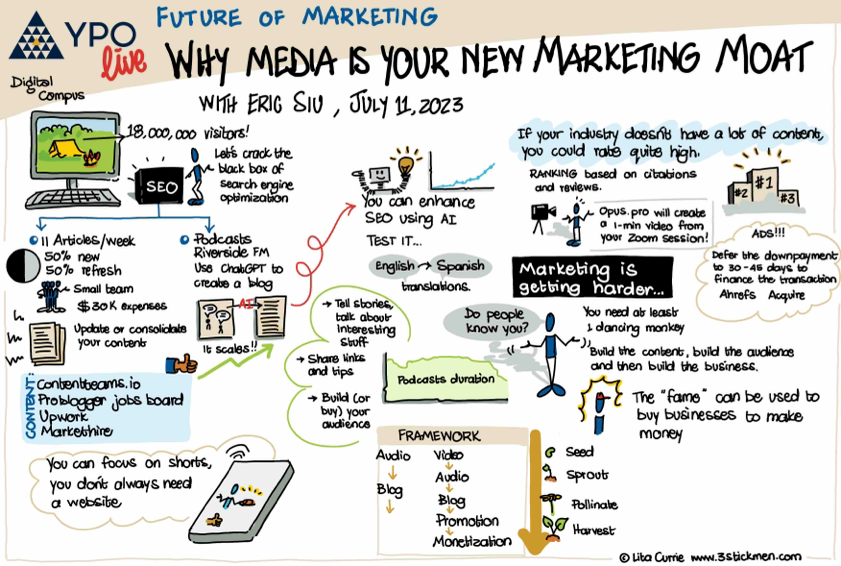
Publish content by considering your audience preferences and product complexity. For instance:
- If your audience responds well to in-depth information, long-form articles or e-books may be suitable.
- If visual demonstration is crucial, videos or infographics might be the way to go.
Additionally, align your content types with your marketing goals: If brand awareness is a priority, podcasts or webinars could help you reach a broader audience.
Regularly analyze the performance of each content type, utilizing metrics like engagement, conversions, and audience feedback to refine your strategy over time.
Step 5 – Content Distribution and Promotion
You should have an excellent distribution strategy to make your content marketing success. Identify the best channels for distributing your content such as social media, email marketing and your company blog.
Here are some of the main ways that you can promote your content.
A) Email Sequences
Most SaaS companies already have email sequences set up to engage new trial users, educate existing users or persuade people against leaving. Therefore, a very effective way to get more people to engage with your content is simply to add another email to your existing sequences.
For example, if your SaaS has a 14-day trial, you could add an email promoting one of your pieces of content to be sent three days before the trial ends, another on day 20, and then another on day 25 – that way, in the future, no one who goes through your trial will miss out on all the great content you’ve been producing:

B) Email Blasts
If you have an existing email list, you can write an email to promote your content and blast it out to everyone (as long as you have permission to do so – GDPR alert!).
Be aware that since the average email click-through rate for software companies is 2.45%, this is most effective when you have a large number of email addresses.
C) PPC Ads
If you don’t already have a large audience, but you do have a reasonable budget, then pay-per-click ads could be the solution. These are all very popular platforms for companies to promote their content:
With Google Ads, you get the huge benefit of being at the top of the search results for any keywords you successfully bid for – without having to invest in SEO:
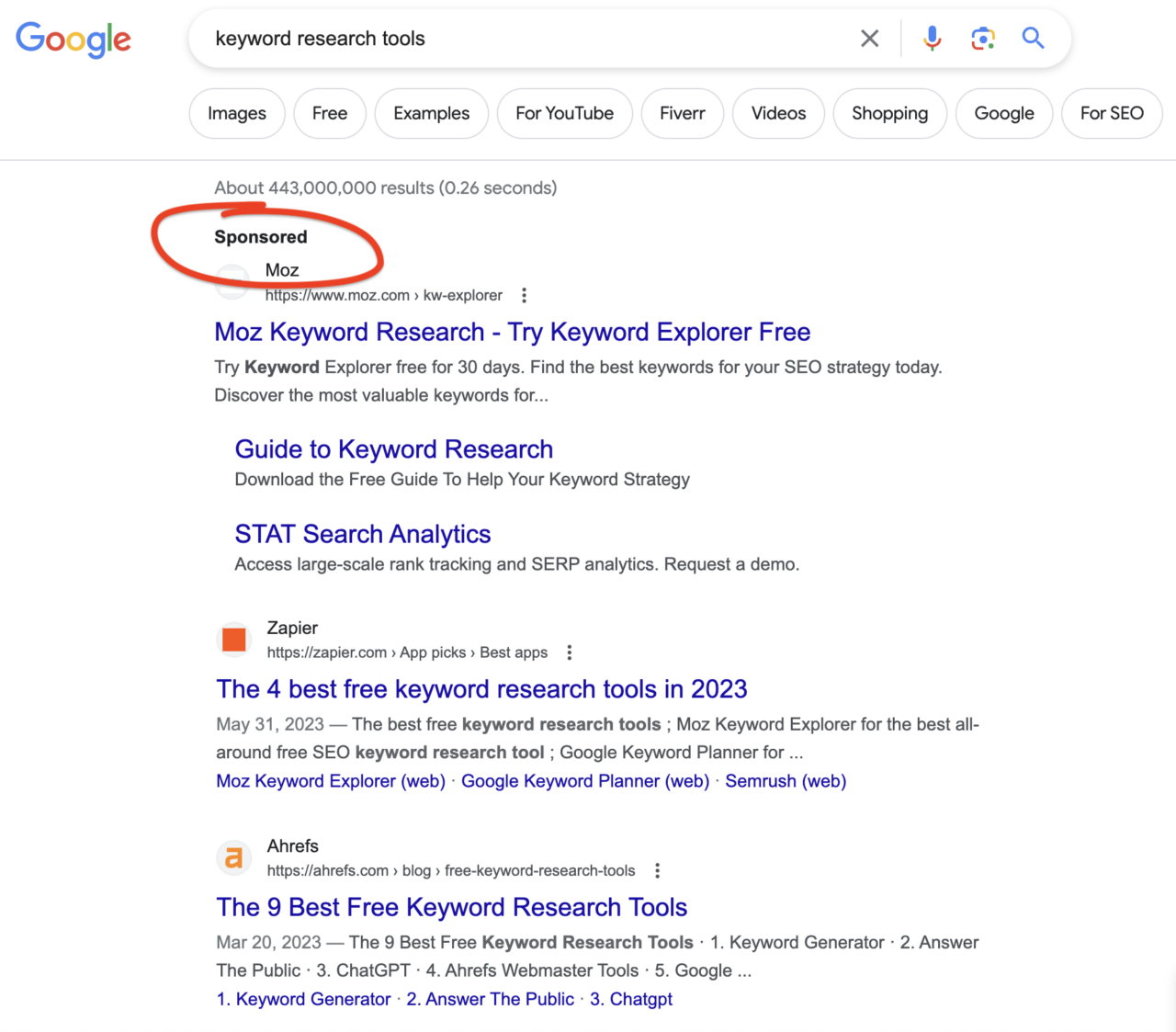
And with the other networks, you get extensive targeting options, including demographics and interests, that make sure your content is seen by the most relevant people.
D) Social Media
If you have an active and engaged following on a social media platform such as Facebook, Twitter, Instagram or LinkedIn, you may be able to promote your latest content releases.
However, just be careful when making this decision that you avoid looking at vanity metrics like follower counts, and instead think about engagement.
For example, Moz, a well-known SEO software company, has over 556,000 followers on Twitter:

Yet, take a closer look and you may be surprised to see that most of their content only gets around 20-50 retweets. That means only around 0.0004% of followers are actively engaged with their content:

The moral of the story? Look at your social media engagement, not just your follower count. 👀
Working with a top paid social media agency can be a great help for this.
E) Forums, Communities and Groups
Depending on your industry, your target users may typically hang out in certain forums, Facebook groups or online communities, which make them ideal places to promote your content.
If you aren’t sure where these places are, remember, you can ask this in your survey during step 3 of the plan. If it’s a community that you belong to (rather than run), just be careful that your plan doesn’t backfire by being too salesy. Most groups have rules about that.
Make sure to reach out to moderators and community owners for permission before posting anything, and try to genuinely engage with the community, too. If the information in your content is genuinely useful and not a sales pitch then most groups are willing to let you share it.
F) Influencers
Partnering with influencers can help SaaS content marketers reach a much larger audience and build social proof for their content:
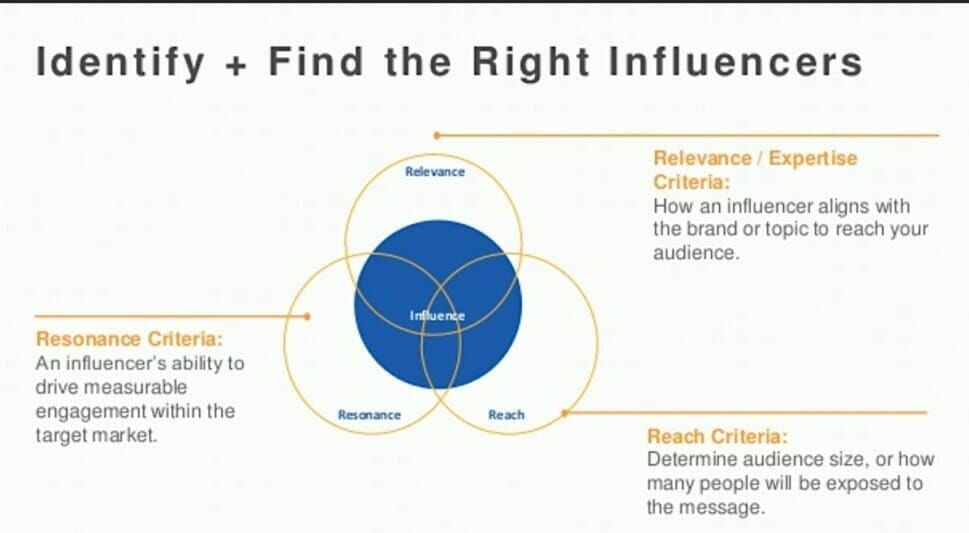
You may even be able to get them to put your content on their own platform (e.g. post videos to their own YouTube channel) to get maximum outreach.
A good idea in order to evaluate your options is to draw up a shortlist of some of the most interesting influencers in your industry. Then, when you find someone you want to reach out to, you can use this checklist to find someone’s email address. If you send cold emails to influencers, it’s likely that only a small percentage will actually respond to your initial email, so be sure to send multiple follow-up emails.
If you’re feeling a bit overwhelmed by the number of methods available to promote your content, don’t be. Instead, start off by thinking about what the easiest and most effective strategy would be for your company.
For example, if you have a list of 100,000 email addresses, but only 200 Facebook followers, it makes sense to pour more effort into email marketing. If you have an existing relationship with a key influencer in your industry, use it to your advantage.
Don’t be afraid to experiment. You can always try a few methods and adjust your strategy later depending on your results.
G) Webinars and Virtual Events
Host webinars or virtual events to promote your SaaS content and engage with your audience in real time:
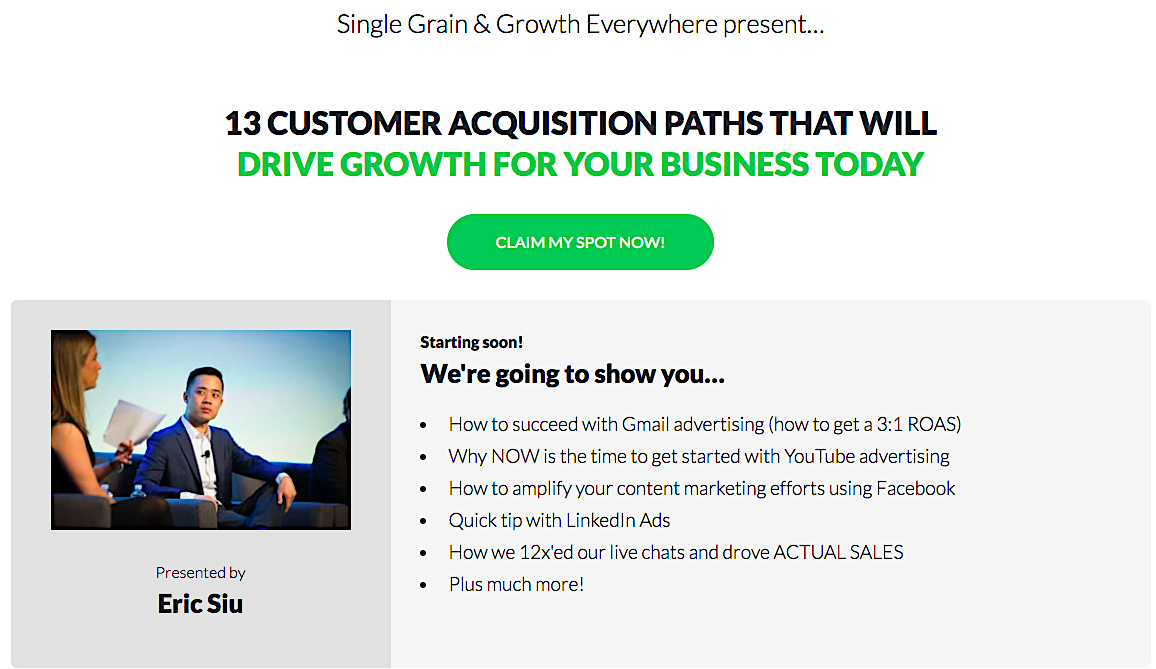
To keep participants engaged, create interactive content incorporating presentations, live demonstrations, Q&A sessions, and polls.
Webinars can significantly contribute to your SaaS content promotion strategy by providing valuable insights and demonstrating practical applications, enhancing brand visibility and user interaction.
Step 6 – Measurement and Analysis
Almost done! Once you’ve taken the time and effort to go through the first five steps, be sure to measure your progress so you can see how your content is doing. That way, you can refine what’s not working well and double down on what is.
Analyzing Your Results
Traffic Analysis:
- Source and Channels: Identify the sources of your website traffic. Understand which channels (organic search, social media, referrals, etc.) are driving the most visitors.
- Page Views and Time on Page: Analyze the pages that receive the most views and the average time visitors spend on those pages. This can indicate the relevance and engagement level of your content.
Conversion Metrics
- Conversion Rate: Assess the conversion rates for different landing pages. Identify high-performing pages and those that may need improvement.
- Conversion Paths: Analyze the customer journey to understand the paths users take before converting. Optimize content to streamline these paths.
User Engagement:
- Bounce Rate: Evaluate the bounce rates for different pages. High bounce rates may indicate irrelevant content or a poor user experience.
- Comments and Social Shares: Monitor social media shares and comments on your content. High engagement suggests that your content resonates with your audience.
- Social Media Metrics: Track the performance of your content on social media platforms. Analyze likes, shares, comments, follower-counts, and click-through rates to gauge social media effectiveness.
SEO Performance
- Keyword Rankings: Check the rankings of your target keywords. Identify high-priority keywords that need improvement and optimize content accordingly.

- Backlink Analysis: Evaluate the quantity and quality of backlinks to your content. Build high-quality backlinks to improve SEO.
Optimizing Content for Higher SERPs Rankings
Analyze the data to identify areas for improvement and optimize your content marketing strategy accordingly. Here are some steps to follow:
Content Relevance
- Analysis: Evaluate content relevance and alignment with audience needs.
- Improvement: Regularly update and refresh content. Fill gaps by creating new content that addresses emerging needs.
Competitor Benchmarking
- Analysis: Compare your content strategy with competitors.
- Improvement: Identify areas where competitors excel and adapt strategies to stay competitive. Address content gaps that competitors may have overlooked.
Mobile and Technical Considerations
- Analysis: Review technical aspects like mobile optimization and site speed.
- Improvement: Ensure that content is mobile-friendly and optimize technical elements for a seamless user experience.
Conversion Paths
- Analysis: Understand the user journey leading to conversions.
- Improvement: Optimize content and navigation to streamline conversion paths, making it easier for users to convert.
Tools to Make SaaS Content Marketing Easier
With the best content marketing tools for SaaS, you can transform your content marketing into a slick operation. Below are my recommendations for which SaaS content marketing platforms you should use for every part of the inbound marketing process.
Systemizing the Production Process
If you try to do content marketing without a project management system in place, there will be complete chaos. But by systemizing the production process you will:
- Ensure consistency in content production
- Be able to easily identify any bottlenecks in the process (What are we waiting for?)
- Cut down on unnecessary communication and calls from team member across different time zones
- Increase the accountability of content team members for their part of the process
- Enforce content timescales and minimize delays
Even if you already have an internal project management tool for other projects, I’d suggest using a separate tool, specifically for your SaaS content marketing strategy.
A) Trello
Trello is fantastic because it’s incredibly simple to use and you can try it for free. While there are many other tools specifically for content marketing, Trello is very easy for all team members to understand, and provides great features for tracking progress.
My recommendation is that you create a Trello board for each type of content (videos, articles, etc.), a list for each stage of the production process, and a card for each piece of content. As each piece of content passes through each stage of production, team members simply drag the card to the next list while adding any comments, deadlines and files.

B) CoSchedule
CoSchedule is a highly capable alternative that’s specifically designed for content marketing. It’s potentially a better alternative for larger companies that are willing to pay between $19-$39 per month per user.
For smaller SaaS companies with large numbers of team members involved in the content production process, this may be prohibitively expensive compared to Trello.

C) Asana
Asana is a versatile project management tool that can be effectively used for content management, providing a structured and collaborative environment for planning, organizing, and executing various content-related tasks.
The tool also lets you create a social media content calendar for easy task management and hitting your SaaS content writing goals.

You can establish specific projects within Asana for different types of content, such as blog posts, social media campaigns, or video production.
Asana also offers project templates that you can customize for different content types, ensuring consistency and efficiency in your workflow.
D) Slack
Slack is a real-time messaging platform that facilitates quick communication among team members. Create dedicated channels for specific content projects to keep discussions organized.

You can set up notifications for key content milestones or approaching deadlines. This makes sure the team is aware of crucial developments and stays on track.
Writing and SEO
A) Airstory
Unlike Microsoft Word or Google Docs, Airstory is built from the ground up for writing content, which means it has cool features like:
- Publish directly to WordPress
- Save research notes using the Chrome extension
- Time travel back through previous versions of your document
- Borderless pages (because “you’re not faxing your document to 1994”) and the ability to drag your notes onto the page
- Highlight text you’ve written and turn it into a note with one click, in case you want to save it for later
- Right click on a picture or highlight text anywhere on the web and send it back to your Airstory document
Best of all, it’s completely free for 97.4% of users.

Other noteworthy alternatives to consider:
- Google Docs – A classic that isn’t going away anytime soon. It’s free to use and easy to collaborate and share docs with others, but the main drawback is that it was built for general users rather than for copywriters, so it lacks a few of the useful features of Airstory.
- Grammarly – A fantastic tool for correcting basic spelling and grammatical errors. With the premium version, you also get more advanced suggestions for sprucing up your copy:
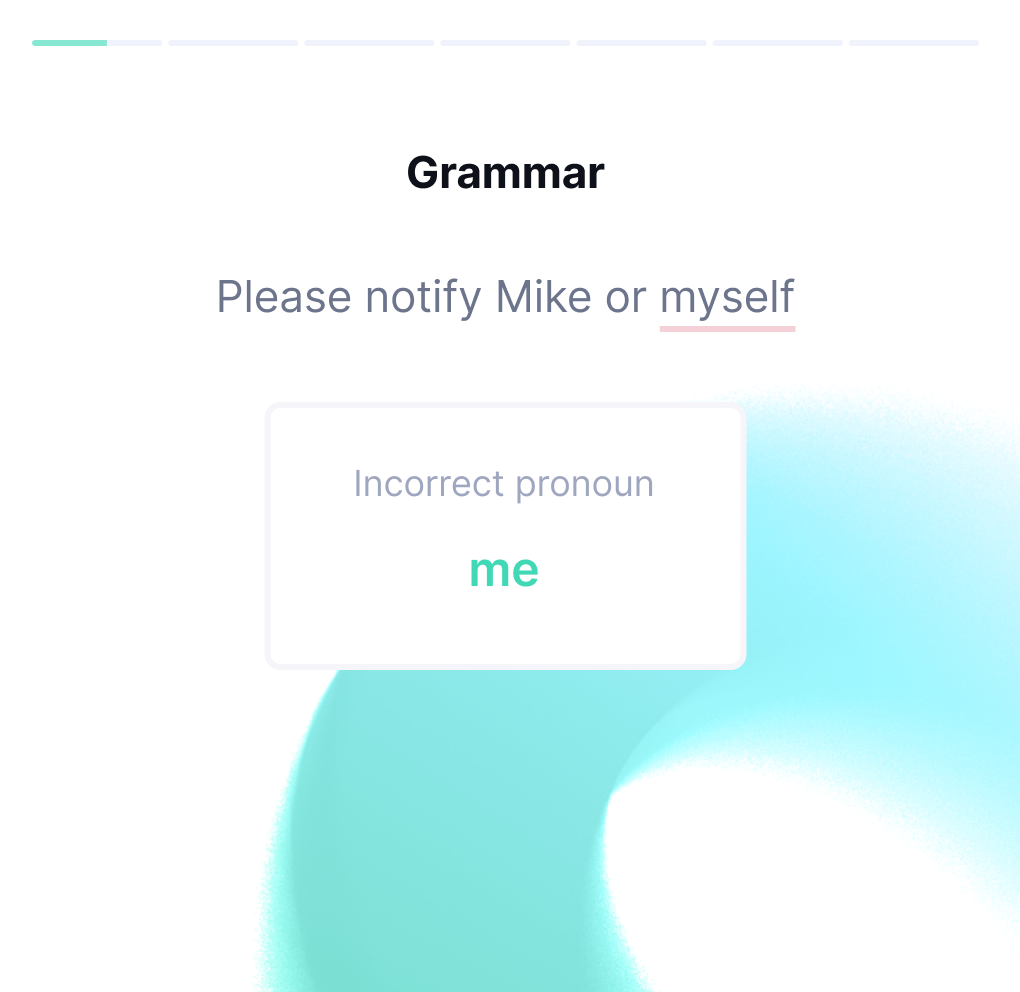
- Canva: A user-friendly design tool to create visually appealing graphics, social media posts, and promotional materials for your SaaS content.
- CoSchedule Headline Analyzer: Analyzes and scores your headlines to improve their effectiveness and engagement.
- Writer – An enterprise tool similar to Grammarly. The difference here is that Writer allows you to upload brand and writing style guidelines so that your content maintains a consistent voice regardless of who’s writing it. Although this is a paid tool, you can get a taste of how their software works by checking out their free grammar checker and proofreading checker tools.
- Yoast – If your SaaS content marketing strategy is built around improving your SEO performance, then you need Yoast. Yoast’s WordPress SEO plugin provides automatic suggestions for optimizing your content to rank better in search engines. Upgrade to the premium version for $89/year and never look back.
Tracking Results
Tracking SaaS content marketing ROI and attributing results from content marketing will depend on which goal you’ve chosen. As such, you may not need all these tools, but here’s a rundown of the ones you should consider.
A) Google Campaign URL Builder
As you promote your content, you’ll need to be able to track where your traffic and sign ups come from in order to attribute them correctly.
Google’s Campaign URL Builder is a free tool that helps you add UTM tags to your links so that you can track the sources and campaigns of your leads:

B) Google Analytics
Google Analytics is still hands-down the best and easiest way to analyze what’s happening on your website. Once set up, you can use it to track everything from traffic to sign-ups. Learn how to set up your goals and funnels in Google Analytics:

C) Pipedrive
You’ll need to use a CRM to capture the details of any leads that sign up as a direct result of your content.
Pipedrive is great at doing this for SaaS companies because not only does it store the UTM details of any sign-ups, it has an easy-to-use sales pipeline. What this means in practice is that you can track which of your sign-ups are free users or upgrades to a paid plan, as well as create filters to display all the leads that come from a specific article or promotional source – making performance reporting super easy.

D) Profitwell
Profitwell is the best tool for tracking advanced SaaS business metrics such as revenue, churn, user engagement and acquisition. And it’s absolutely free to use.

E) Mention
If the main goal of your SaaS content marketing strategy is to increase brand awareness, then consider using Mention. This tool helps you to monitor the web and social media for mentions of your brand, allowing you to see what’s being said and how your brand is being perceived.

Lastly, make sure to read our article on SaaS SEO to see the best ways to track the results of an SEO-focused content marketing strategy.
Content Promotion
A) Buffer
Take the stress away from publishing promotional social media posts. Buffer can post for you on Facebook, Twitter, Instagram, LinkedIn and Pinterest – and analyze your campaigns, too.

B) Mailchimp
Mailchimp is an email marketing platform for creating and distributing newsletters and targeted email campaigns.

It lets you set up automated email campaigns based on user actions, such as sign-ups or trial activations. This ensures timely and targeted content delivery to your audience, nurturing leads and driving engagement.
You can plan and schedule your newsletters to be sent at optimal times, maximizing open rates and engagement.
C) Hootsuite
Hootsuite is a social media management platform for boosting SaaS content promotion. It streamlines social media tasks, enhances engagement, and delivers insightful analytics.

With its centralized dashboard, users can efficiently oversee multiple social media accounts spanning platforms like Facebook, Twitter, LinkedIn, Instagram, and others, simplifying content distribution across various marketing channels.
You can upload and schedule multiple posts simultaneously using the bulk scheduling feature. This is particularly useful for planning content calendars and ensuring a steady stream of posts.
Examples of SaaS Companies with Great Content Marketing
Looking for some inspiration? Here are two examples of SaaS companies that have been super successful with their content marketing efforts.
Gong
Gong.io is a leading provider of AI-driven solutions designed to transform customer interactions into actionable insights for strategic decision-making within sales teams.

Their content marketing strategy provides a blueprint for SaaS content success that you can replicate by understanding and implementing key principles.
First and foremost, they established a centralized blog as their content home base to tailor categories for a clearly defined audience base, delivering a diverse range of valuable content. They focused on publishing unique data-driven insights to set their content apart as informative and exclusive.
After that, they repurposed content for social channels, especially those where your audience is actively engaged. For example, their creative content “The Startling Truth: How Cursing Impacts Sales” sparked engagement and meaningful conversations:

The company aimed to build a community through thought leadership by utilizing PR content, guest posts, and authoritative articles to position your brand as an industry leader.
They focused on engagement metrics, like LinkedIn followers, as they can be more telling than mere traffic numbers and fostered a community through contests, giveaways, and humanizing your SaaS brand.

Gong.io’s success lies in a holistic approach, combining diverse content formats, engaging with the community, and leveraging unique data to stand out in the market. Understanding these principles allows you to replicate and tailor their strategies to elevate your content marketing endeavors.
HubSpot
If you’re looking to create an SEO-based content marketing strategy, then HubSpot is a great example to follow.

This platform provides sales and marketing software, which is a very competitive niche, yet their strategy is incredibly simple – consistently create high quality content for all parts of the marketing funnel, from TOFU articles such as “how to write a blog post” to BOFU content like “how to use a CRM”:

The idea behind this is one that can be replicated by most other SaaS companies: By focusing on content throughout the marketing funnel, not only do they attract new users who are ready to buy now, but they also build long-term brand awareness from marketers who aren’t ready to buy yet, but may do so in the future.
As a result of this focus, HubSpot has managed to 3X their organic traffic in just under five years, and rank between #1-3 for nearly 13,000 keywords in organic search.
Final Thoughts on SaaS Content Marketing
With SaaS companies becoming less differentiated by features alone, content is becoming a major factor in users’ purchasing decisions. If your advertising and sales team acts now to build a long-term SaaS content marketing strategy, then you have the power to become the #1 software company in your industry. Best of luck!
If you’re ready to amplify your SaaS brand’s exposure with quality content, Single Grain’s SaaS content marketing experts can help!👇
Additional content contributed by Joydeep Bhattacharya.



